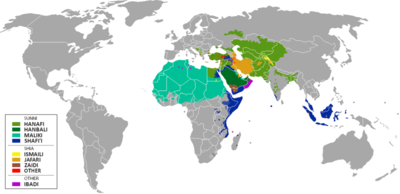Maliki school
The Sunnah and Hadith, or prophetic tradition in Islam, played lesser roles as Maliki jurists viewed both with suspicion, and few were well versed in either.[16] While the majority of the United Arab Emirates and Saudi Arabia follows Hanbali laws, the country's Eastern Province has been known as a Maliki stronghold for centuries.[3] Although initially hostile to some mystical practices, Malikis eventually learned to coexist with Sufi customs as the latter became widespread throughout North and West Africa.[17] The Maliki school's sources for Sharia are hierarchically prioritized as follows: Quran and then widely transmitted Hadiths (sayings, customs and actions of Muhammad); `Amal (customs and practices of the people of Medina), followed by Ahad Hadith, and then followed by consensus of the Sahabah (the companions of Muhammad), then individual opinion from the Sahabah, Qiyas (analogy), Istislah (interest and welfare of Islam and Muslims), and finally Urf (custom of people throughout the Muslim world if it did not contradict the hierarchically higher sources of Sharia).[2] The example of Maliki approach in using the opinion of Sahabah were recorded in Muwatta Imam Malik per ruling of cases regarding the law of consuming Gazelle meat.Malik bin Anas himself also accepted binding consensus and analogical reasoning along with the majority of Sunni jurists, though with conditions.


Maliki (disambiguation)Sunni IslamBeliefsProphets and MessengersHoly booksSuccession to MuhammadAngelsJudgement DayPredestinationSahabaFive PillarsDeclaration of FaithPrayerCharityFastingPilgrimageRightly-Guided CaliphsAbu BakrUthmanSchoolsHanafiShafi'iHanbaliZahiriAwza'iThawriLaythiJaririSchools of theologyAsh'arismMaturidismAhl al-Ra'yAtharismAhl al-Hadithal-Wijdanal-KashfBarelvi movementDeobandi movementSalafismWahhabismAhl-i HadithModernismNeo-traditionalismFarahiHoly sitesMedinaJerusalemLiteratureKutub al-SittahPersecutionArabicromanizedIslamic jurisprudenceMalik ibn AnashadithsIslamic lawShafi’iShariaMalikiNorth AfricaWest AfricaKuwaitBahrainEmirate of DubaiSaudi Arabiamedieval eraEurope under Islamic ruleIslamic SpainEmirate of SicilyMosque of UqbaAbbasidsAsh-Shafi‘iAhmad ibn HanbalJa'far al-SadiqdescendantIslamic prophetMuhammadShi'ite ImamAbu HanifahUmayyadsAndalusAlmoravidsSunnahHadithAlmohadsReconquistaAl-AndalusArab States of the Persian GulfEastern ProvinceSahabahIstislahMuwatta Imam MalikGazelleZubayr ibn al-AwwamGreat Mosque of KairouanKairouanTunisiamujtahidSahnunQur'anrightly guidedcaliphsbinding consensusanalogical reasoningsecondYahya al-LaithiMudawwanahIbn Abi ZaydYusuf ibn abd al-BarrIbn TashfinAlmoravid dynastyQadi IyadIbn RushdAverroesAl-QurtubiShihab al-Din al-QarafiKhalil ibn Ishaq al-JundiMukhtasarIbn BattutaIbn KhaldūnMuqaddimahAbu Ishaq al-ShatibiSidi BoushakiSidi Abd al-Rahman al-Tha'alibiSidi Ahmed RguibiReguibat tribe